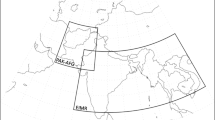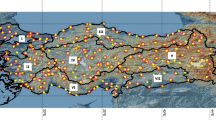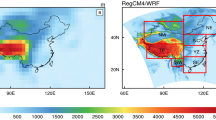Abstract
Three models, MM5, COAMPS, and WRF, have been applied for the warm season in 2003 and the cool season in 2003–2004 to evaluate their performances. All models run over the same domain area covering the north Gulf Mexico and southeastern United States (US) region with the same spatial resolution of 27 km. It was found that the temporal variations of the mean error distribution and strength at 24 and 36 h were rather weak for surface temperature, sea level pressure, and surface wind speed for all models. A warm bias in surface temperature forecasts dominated over land during the warm season, whereas a cool bias existed during the cool season. The MM5 and WRF produced negative biases of sea level pressure during the warm season and positive biases during the cool season while the COAMPS yielded a similar distribution of sea level pressure biases during both seasons. During both seasons, similar surface wind speed biases produced by each model included a high wind speed forecast over most areas by MM5 while the COAMPS and WRF yielded weak surface winds over the western Plains and stronger surface winds over the eastern Plains. Root-mean-squared errors revealed that the forecast of surface temperature, sea level pressure, and surface wind speed were degraded with the increase of forecast time. For rainfall evaluation, it was found that the MM5 underpredicted seasonal precipitation while the COAMPS and WRF overpredicted. The bias scores revealed that the MM5 yielded an underprediction of the coverage of precipitation areas, especially for heavier rainfall events. The MM5 presented the lower threat score at lighter rainfall events compared to the COAMPS and WRF. For moderate and heavier thresholds, all models lacked forecast accuracy. The WRF accuracy in predicting precipitation was heavily dependent upon the performance of the selected cumulus parameterization scheme. Use of the Grell–Devenyi and Bette–Miller–Janjic schemes helps suppress precipitation overprediction.












Similar content being viewed by others
References
Baker NL (1992) Quality control for the U.S. Navy operational database. Wea Forcast 7:250–261
Baldwin ME, Mitchell KE (1997) The NCEP hourly multisensor U.S. precipitation analysis for operations and GCIP research. Preprints. In: 13th conference on hydrology, Long Beach, CA. American Meteorological Society, pp 54–55
Barnes SL (1964) A technique for maximizing details in numerical weather map analysis. J Appl Meteor 3:396–409
Betts AK, Miller MJ (1986) A new convective adjustment scheme. Part I: Observational and theoretical basis. Q J R Meteor Soc 112:677–692
Betts AK, Miller MJ (1993) The Betts-Miller scheme. The representation of cumulus convection in numerical models. Meteor Monogr Am Meteor Soc 46:107–121
Cairns MM, Miller RJ, Chen J, Marroquin A, Mahoney JL (1994) A second evaluation of aviation-impact variables generated by the Eta Model. NOAA Tech Memo ERL FSL-14. NOAA/Forecast Systems Laboratory, Boulder, CO, p 94
Cheng WYY, Steenburgh WJ (2005) Evaluation of surface sensible weather forecasts by the WRF and Eta models over the Western United States. Wea Forecast 20:812–821
Colby FP Jr (1998) A preliminary investigation of temperature errors in operational forecasting models. Wea Forecast 13:187–205
Colle BA, Westrick KJ, Mass CF (1999) Evaluation of the MM5 and Eta-10 precipitation forecasts over the Pacific Northwest during the cool season. Wea Forecast 14:137–154
Colle BA, Mass CF, Westrick KJ (2000) MM5 precipitation verification over the Pacific Northwest during the 1997-99 cool seasons. Wea Forecast 15:730–744
Colle BA, Mass CF, Ovens D (2001) Evaluation of the timing and strength of MM5 and Eta surface trough passage over the eastern Pacific. Wea Forecast 16:553–572
Colle BA, Olson JB, Tongue JS (2003a) Multiseason Verification of the MM5. Part I: Comparison with Eta Model over the Central and Eastern United States and impact of MM5 resolution. Wea Forecast 18:431–457
Colle BA, Olson JB, Tongue JS (2003b) Multiseason Verification of the MM5. Part II: Evaluation of high-resolution precipitation forecasts over the northeastern United States. Wea Forecast 18:458–480
Dudhia J (1989) Numerical study of convection observed during the winter monsoon experiment using a mesoscale two-dimensional model. J Atmos Sci 46:3077–3107
Fowle MA, Roebber PJ (2003) Short-range numerical prediction of convective occurrence, mode, and location. Wea Forecast 18:782–794
Gal-Chen T, Somerville RCJ (1975) On the use of a coordinate transformation for the solution of the Navier-Stokes equations. J Comput Phys 17:209–228
Gallus WA Jr (1999) Eta simulations of three extreme precipitation events: sensitivity to resolution and convective parameterization. Wea Forecast 14:405–426
Gallus WA Jr (2006) Comparison of impacts of WRF dynamic core, physics package, and initial conditions on warm season rainfall forecast. Mon Wea Rev 134:2632–2641
Grell GA (1993) Prognostic evaluation of assumptions used by cumulus parameterizations. Mon Wea Rev 121:764–787
Grell GA, Dudhia J, Stauffer DR (1994) A description of the fifth generation Penn State/NCAR Mesoscale Model (MM5). NCAR Tech. Note NCAR/TN-398 + 1A. National Center for Atmospheric Research, Boulder, CO, p 107
Grimit EP, Mass CF (2002) Initial results of a mesoscale short-range ensemble forecasting over the Pacific Northwest. Wea Forecast 17:192–205
Hanna SR, Yang R (2001) Evaluation of mesoscale models’ simulations of near-surface winds, temperature gradients, and mixing depths. J Appl Meteor 40:1095–1104
Harshvardhan RD, Randall D, Corsetti T (1987) A fast radiation parameterization for atmospheric circulation models. J Geophys Res 92:1009–1016
Hodur RM (1997) The navy research laboratory’s coupled ocean/atmosphere mesoscale prediction system (COAMPS). Mon Wea Rev 125:1414–1430
Hong JS (2003) Evaluation of the High-Resolution Model forecasts over the Taiwan Area during GIMEX. Wea Forecast 18:836–846
Hong SY, Pan HL (1996) Nonlocal boundary layer vertical diffusion in a medium-range forecast model. Mon Wea Rev 124:2322–2339
Hong SY, Juang HMH, Zhao Q (1998) Implementation of prognostic cloud scheme for a regional spectral model. Mon Wea Rev 126:2621–2639
Hummel JR, Reck RA (1979) A global surface albedo model. J Appl Meteor 18:239–253
Janjic ZI (1994) The step-mountain eta coordinate model: further developments of the convection, viscous sublayer, and turbulence closure schemes. Mon Wea Rev 122:928–945
Kain JS, Fritsch JM (1993) Convective parameterization for mesoscale models: the Kain–Fritsch scheme. The representation of cumulus convection in numerical models, Meteor Monogr 46. American Meteorological Society, pp 165–170
Klemp JB, Durran DR (1983) An upper boundary condition permitting internal gravity wave radiation in numerical mesoscale models. Mon Wea Rev 111:430–444
Klemp J, Wilhelmson R (1978) The simulation of three-dimensional convective storm dynamics. J Atmos Sci 35:1070–1096
Manning KW, Davis CA (1997) Verification and sensitivity experiments for the WISP94 MM5 forecasts. Wea Forecast 12:719–735
Mass CF, Kuo YH (1998) Regional real-time numerical weather prediction: current status and future potential. Bull Am Meteorol Soc 79:253–263
Mass CF, Ovens D, Westrick KJ, Colle BA (2002) Does increasing horizontal resolution produce better forecast? The results of two years of real-time numerical weather prediction in Pacific Northwest. Bull Am Meteorol Soc 83:407–430
Mellor GL, Yamada T (1982) Development of a turbulence closure for geophysical fluid problems. Rev Geophys Space Phys 20:851–875
Mesinger F (1996) Improvements in quantitative precipitation forecasts with the Eta regional model at the National Center for Environmental Prediction: the 48-km upgrade. Bull Am Meteorol Soc 77:2637–2649
Mlawer EJ, Taubman SJ, Brown PD, Iacono MJ, Clough SA (1997) Radiative transfer for inhomogeneous atmosphere: RRTM, a validated correlated-k model for the long-wave. J Geophys Res 102(D14):16663–16682
Nutter P, Manobianco J (1999) Evaluation of the 29-km Eta Model. Part I: Objective verification at three selected stations. Wea Forecast 14:5–17
Olson DA, Junker NW, Korty B (1995) Evaluation of 33 years of quantitative precipitation forecasts at NMC. Wea Forecast 10:498–511
Oncley SP, Dudhia J (1995) Evaluation of surface fluxes from MM5 using observations. Mon Wea Rev 125:3344–3357
Petersen RA, Stackpole JD (1989) Overview of the NMC production suite. Wea Forecast 4:313–322
Rutledge SA, Hobbs PV (1983) The mesoscale and microscale structure and organization of clouds and precipitation in midlatitude cyclones. XIII: A model for the “seeder-feeder” process in warm-frontal rainbands. J Atmos Sci 40:1185–1206
Schwartz BE, Benjamin SG (2000) Verification of RUC-2 precipitation forecasts using the NCEP multisensor analysis. Preprints. In: 4th symposium on international observing systems, Long Beach, CA. American Meteorological Society, pp 182–185
Skamarock WC, Klemp JB, Dudhia J (2001) Prototypes for the WRF (Weather Research and Forecasting) model. Reprints. In: 9th conference on mesoscale processes, Fort Lauderdale, FL. American Meteorological Society, pp J11–J15
Stensrud DJ, Bao JW, Warner TT (2000) Using initial condition and model physics perturbations in short-range ensemble simulations of mesoscale convective system. Mon Wea Rev 128:2077–2107
Wang W, Seaman NL (1997) A comparison study pf convective parameterization schemes in a mesoscale model. Mon Wea Rev 125:252–278
White GB, Paegle J, Steenburgh WJ, Horel JD, Swanson RT, Cook LK, Onton DJ, Miles JG (1999) Short-term forecast validation of six models. Wea Forecast 14:84–108
Wilks DS (1995) Statistical methods in atmospheric sciences: an introduction. Academic Press, New York
Wilson MF, Henderson-Sellers A (1985) A global archive of land cover and soils data for use in general circulation climate models. J Climatol 5:119–143
Acknowledgments
This research was supported by the NOAA Center for Atmospheric Sciences (NCAS) through Grant NA17AE1623. The uses of MM5 and WRF were made possible by the Microscale and Mesoscale Meteorological Division of the National Center for Atmospheric Research, which is supported by the National Science Foundation. COAMPS was made available by the Fleet Numerical Meteorology and Oceanograph Center in Monterey through a Memorandum of Agreement.
Author information
Authors and Affiliations
Corresponding author
Additional information
Responsible editor: C. Simmer.
Rights and permissions
About this article
Cite this article
Lu, D., White, L., Reddy, R.S. et al. Multiseason evaluation of the MM5, COAMPS and WRF over southeast United States. Meteorol Atmos Phys 111, 75–90 (2011). https://doi.org/10.1007/s00703-011-0124-1
Received:
Accepted:
Published:
Issue Date:
DOI: https://doi.org/10.1007/s00703-011-0124-1




